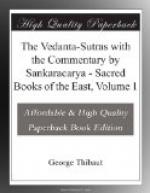PADA IV.
The last pada of the first adhyaya is specially directed against the Sa@nkhyas.
The first adhikara/n/a (1-7) discusses the passage Ka/th/a Up. I, 3, 10; 11, where mention is made of the Great and the Undeveloped—both of them terms used with a special technical sense in the Sa@nkhya-sastra, avyakta being a synonym for pradhana.—Sa@nkara shows by an exhaustive review of the topics of the Ka/th/a Upanishad that the term avyakta has not the special meaning which the Sa@nkhyas attribute to it, but denotes the body, more strictly the subtle body (sukshma sarira), but at the same time the gross body also, in so far as it is viewed as an effect of the subtle one.
Adhik. II (8-10) demonstrates, according to Sa@nkara, that the tricoloured aja spoken of in Sve. Up. IV, 5 is not the pradhana of the Sankhyas, but either that power of the Lord from which the world springs, or else the primary causal matter first produced by that power.—What Ramanuja in contradistinction from Sa@nkara understands by the primary causal matter, follows from the short sketch given above of the two systems.
Adhik. III (11-13) shows that the pa/nk/a pa/nk/ajana/h/ mentioned in B/ri/. Up. IV, 4, 17 are not the twenty-five principles of the Sa@nkhyas.—Adhik. IV (14, 15) proves that Scripture does not contradict itself on the all-important point of Brahman, i.e. a being whose essence is intelligence, being the cause of the world.
Adhik. V (16-18) is, according to Sa@nkara, meant to prove that ’he who is the maker of those persons, of whom this is the work,’ mentioned in Kau. Up. IV, 19, is not either the vital air or the individual soul, but Brahman.—The subject of the adhikara/n/a is essentially the same in Ramanuja’s view; greater stress is, however, laid on the adhikara/n/a being polemical against the Sa@nkhyas, who wish to turn the passage into an argument for the pradhana doctrine.
The same partial difference of view is observable with regard to the next adhikara/n/a (VI; Sutras 19-22) which decides that the ’Self to be seen, to be heard,’ &c. (B/ri/. Up. II, 4, 5) is the highest Self, not the individual soul. This latter passage also is, according to Ramanuja, made the subject of discussion in order to rebut the Sa@nkhya who is anxious to prove that what is there inculcated as the object of knowledge is not a universal Self but merely the Sa@nkhya purusha.
Adhik. VII (23-27) teaches that Brahman is not only the efficient or operative cause (nimitta) of the world, but its material cause as well. The world springs from Brahman by way of modification (pari/n/ama; Sutra 26).—Ramanuja views this adhikara/n/a as specially directed against the Se/s/vara-sa@nkhyas who indeed admit the existence of a highest Lord, but postulate in addition an independent pradhana on which the Lord acts as an operative cause merely.




